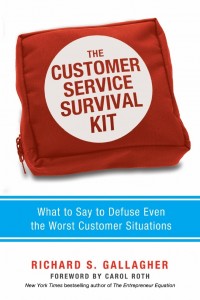 As someone who spent much of his career managing customer contact centers, you might be surprised to learn the real reason for most bad service. It isn’t rudeness. It isn’t indifference. It is FEAR. People worry about twisting helplessly in the wind if a customer goes off on them, so they approach each and every customer from a defensive posture.
As someone who spent much of his career managing customer contact centers, you might be surprised to learn the real reason for most bad service. It isn’t rudeness. It isn’t indifference. It is FEAR. People worry about twisting helplessly in the wind if a customer goes off on them, so they approach each and every customer from a defensive posture.
How do you fix this? By learning the same skills that hostage negotiators, crisis counselors, and police officers use in their worst situations. Teaching my own teams these kinds of skills was the key to transforming their performance. Here are a few of the best ones:
Lean into criticism. A customer is pounding his fist on the table telling you that your product stinks. How do you respond? Meet them where they are at emotionally, and walk right into the flames: “Wow, that must have really inconvenienced you! You must be FURIOUS about that.” Do this, and you will lower the heat and open productive dialogue.
Acknowledge their agenda. Most of us are so afraid of agreeing with an angry customer that we never think to acknowledge them – which you can do all day if you wish. Just paraphrase their words (“You were hoping this would have turned out differently”), observe their feelings (“This was really frustrating for you”), validate them (“Everyone hates situations like these”), or identify with them (“I would have felt the same way too”).
Avoid trigger phrases. You are a nice person. You would never knowingly insult a customer. But if you are like most people, you don’t even think about using phrases that give orders (“You’ll have to fill out these forms”), have become shopworn with overuse (“I understand” – no you don’t), or distance the customer (“I don’t know what to tell you” – then quick, find someone who does!). Cut phrases like these out of your vocabulary and you’ll experience much less anger.
Power up your problem solving. Make your solutions more attractive by clarifying what the customer wants, framing your solutions around these wants, and selling their benefits. What would you prefer, a snippy “I’m sorry, sir, you’ll have to wait three days” or a cooperative “I know you want this as soon as possible, so I am going to personally make sure that someone responds to you within 72 hours”?
When a call comes in to the police, they don’t respond by holding their heads in their hands and saying, “Oh my goodness, someone is stealing something!” Instead, they do what they have been trained over and over to do. In the same way, learn how to execute in your worst customer situations and you will provide awesome service to every customer, every time.
P.S. SHAMELESS PLUG: If you like techniques like these, my new book The Customer Service Survival Kit – with a foreword by our genial host Carol Roth – is chock full of them. It launches today with lots of free gifts, up to and including access to me! Check it out at www.customerservicesurvivalkit.com.

